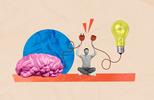6 building blocks for successful collaboration – the compass for digitally distributed setups

The coronavirus pandemic has had an enduring impact on the world of work. The question now is not when the “old normal” will return, but how much of it will be reinstated within the “new normal”. One thing is clear – digitally distributed collaboration is here to stay. That applies whether it’s on-site in an open-plan office – which is reaching a whole new level thanks to increasing digitalization – or in business units that operate on a decentralized basis, with exclusively digital communication.
Rethink things earlier so as not to lose out later
Adopting a “digital first” approach won’t just have given companies an edge at the start of the pandemic, it will also continue to benefit their business in the post-pandemic world. Less business travel, more working from home, flexible working hours and decentralized teams will still be integral aspects of working life in many places after the pandemic. That’s why it pays to consistently gear your collaboration toward a “digital first” approach and make full use of the associated opportunities, such as making information easier for everyone to find and facilitating collaboration on both a synchronous and asynchronous basis.
Whether you take a short-term outlook or a longer perspective, it’s a good idea not to force on-site processes and methods ruthlessly onto digitally distributed setups. Adopting a holistic view of digitally distributed collaboration and putting in place appropriate measures to support location-independent collaboration pays off. When you look at the bigger picture, it very quickly becomes clear where efficiency gains can be made – and where there are challenges that need to be addressed. Every change will involve some disadvantages, too, but if you take these into account early on, your efforts will be rewarded all the sooner.
Efficient collaboration boosts productivity and makes work more enjoyable – which, in turn, directly feeds into the quality of results. Putting resources into developing a coherent concept for collaboration, regularly reviewing that concept and making the necessary adjustments is therefore a sound investment choice. In these dynamic times, being competitive means not just being willing to take on new tasks, but also being flexible in the way we work together.
The birth of the tts Digital Boost approach
As a company that chose to adopt a “digital first” approach relatively early on, we have built up many years of valuable experience with various aspects of digital collaboration. tts has a decentralized structure and a long track record of working with many very different forms of collaboration. We have teams of different sizes and structures, including line teams, back office teams and scrum teams, as well as project teams that change on a regular basis and others that are pretty consistent. We offer advice, create concepts, implement software, safeguard operations, lead strategy workshops, customize training, plan large internal and external digitally distributed events and do much more besides. What’s more, our intensive work with customers has given us numerous insights into virtually every form of digital collaboration imaginable.
We have taken all this valuable experience, combined it and structured it so we can leverage it. This has given rise to a range of supportive tools that are helping shape successful digitally distributed collaboration – the tts Digital Boost. Despite what its name might suggest, this innovative approach goes well beyond the digital realm and is actually based on six building blocks that are relevant to collaboration in any context. The specific make-up of these building blocks should, however, be varied to suit the relevant setup and context.
Six building blocks for successful collaboration
Our six building blocks for successful collaboration are just as important for synchronous on-site cooperation as they are for digitally distributed and hybrid setups.
Clear Structure
Having a clear structure means putting in place a solid basis for effective collaboration. Creating a framework, for instance by providing the right channels of collaboration and shared storage locations, promotes a transparent and efficient approach to work. Thorough preparation, standardized rituals, known contacts and communal (virtual) spaces offer support and help everyone understand where they are and what they’re doing on a day-to-day basis. Even just having a standardized filing structure and naming system for relevant documents can ultimately save several hours of work that would otherwise be wasted on searching.
Sense of Belonging
There are two sides to a sense of belonging – feeling that you are part of something and a perception of togetherness. It’s about knowing you are part of a team, part of a company and – in terms of your work – part of a greater purpose. One thing in particular really boosts a person’s intrinsic motivation, and that is being able to see how the awareness, importance and added value of your own personal contribution fits into the bigger picture (see Drive by Daniel Pink). Social cohesion and mutual trust promote a sense of togetherness and productivity within a team. A pleasant and trusting atmosphere nurtures a good underlying sentiment that is much more conducive to successful collaboration.
Readiness to Change
In our current dynamic times, readiness to change is about being able to respond quickly and flexibly to changes, often in a way that is decisive for a company’s competitiveness. However, changes are often challenging in the initial stages, and can quickly be met with resistance. All the same, experience shows that change processes meet with a better reception when the reasons for the change are readily identifiable. A company needs to have an open and reflective corporate culture if it is to recognize the need and potential for changes. For instance, regular retrospectives trigger collective learning processes that foster an openness to new things. After initial successes in change processes, readiness to change tends to improve further.
Result Orientation
This building block dictates that collaboration should always be focused on generating value, for either internal or external stakeholder groups as appropriate to the working context. The prerequisite for creating value is knowing the needs of the stakeholder groups. Once these are known – either by using personas, design thinking or user journey maps – the team can develop a shared vision. When targets and planning are defined as part of a collective effort, it boosts commitment, which ensures objectives are pursued with focus. Lean-agile approaches can also be taken to keep processes as lean and customer-centered as possible. Principle No. 10 of the Agile Manifesto sums this up pretty much perfectly: Simplicity – the art of maximizing the amount of work not done – is essential (see https://agilemanifesto.org/principles.html).
Learning-friendly Culture
This building block is particularly relevant right now, in a world full of VUCA (volatility, uncertainty, complexity, ambiguity), where we are continuously being forced to deal with changed circumstances. That’s why it is important that companies create a culture and organizational framework in which knowledge and experience can be shared and discussed. Moreover, staff don’t just want the opportunity to contribute their skills, they also want a chance to improve them and gain mastery over their job, so to speak (see Drive by Daniel Pink). Meeting that drive to learn new things not only nurtures motivation, it has also been shown to enhance creativity and a passion for innovation. That is why it is crucially important for companies to factor in learning time – both for individuals and as a team.
Method Diversity
Since everyone reacts differently, “method diversity” is an essential building block of successful collaboration as a means of bringing variation to the types of cooperation pursued. After all, different people find different formats and methods work best for them, and thus also encourage them to contribute. In addition, varying formats in this way (using what are known as “liberating structures”: https://liberatingstructures.de/liberating-structures-menue/) makes it easier for participants to reflect, focus and engage. It is, however, important to strike a healthy balance so as not to overload participants. That means it’s better to use your judgement and expand or swap out methods occasionally, rather than constantly introducing new methods and tools. When looking at options, it is important to put the purpose first, then choose the method and finally select the tools.
The compass for digitally distributed collaboration
Instead of setting out a strict checklist for the route to success, these building blocks create more of a framework for regular self-reflection and are ideal for digitally distributed setups. They provide inspiration and help identify potential for improvement, establish progress and determine the next steps and overall development. Like a compass, they guide companies to a more effective form of digitally distributed collaboration – and precisely like the classic navigational tool, they point in the right direction, but don’t provide a detailed roadmap. The precise route will vary for each and every organization, depending on requirements and preferences.
Utilizing these building blocks as a guide helps with the very real task of successfully changing the way we work together as physical location becomes increasingly less important. This approach also offers a means of finding the optimum processes, structures, methods, setups and tools for collaboration once social distancing is no longer required.
It is important to bear in mind that the tts Digital Boost approach is not about running any single meeting or training course efficiently, but more about designing a harmonious, holistic, trusting and efficient sense of togetherness in digitally distributed scenarios. These building blocks help to keep the key factors in view and sometimes even shift them out of the blind spot and into full view.
Enthusiasm for collaboration as a central element of culture
As previously mentioned, digital collaboration across different locations and time zones has been part and parcel of what we do at tts for years. The building blocks presented here are based on this experience, but they are more than just a tool for advising our customers. Instead, they are integral to the culture we have cultivated within our own company – and they play an important part in concepts and reflections.
These building blocks are also in evidence in our collaboration with customers, some of which is not tied down to particular locations. We know that, as a trustworthy partner, it is not just concrete results that are important, but also an enthusiasm for collaboration. This enthusiasm – and the conditions it needs in order to thrive – are an elementary aspect of the “mindset” behind these building blocks.
That’s why we invite you to reflect on your own collaboration with regard to the six building blocks. I’m confident you will see certain things in a new light. Talking about a new light, if you are interested in exploring this issue in more depth, we’d be happy to cast our expert eye over collaboration in your own context. That could soon see you add another term to your extended vocabulary alongside “new normal”, “breakout session” and “Zoom fatigue” – Digital Boost.





